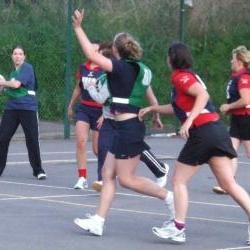Return to Netball Training: A physio’s perspective.
How to prevent a netball injury
 I went to netball training last night with the Tiverton Terriers. It was a cold, damp evening with areas of surface water on the court. It was the first session of the year, all of us de-conditioned from the Christmas break but pleased to be back to enjoy the game and catch up with friends.
I went to netball training last night with the Tiverton Terriers. It was a cold, damp evening with areas of surface water on the court. It was the first session of the year, all of us de-conditioned from the Christmas break but pleased to be back to enjoy the game and catch up with friends.
As a Physiotherapist, my team mates will often ask me for advice on their current injuries. Netball is known for being a ‘high risk’ sport.
It is a game prone to ankle and knee injuries due to the sudden changes in direction, rapid acceleration and recurrent landings required (More detail here)
Females are up to 6 times more likely to sustain a significant knee injury during ‘high risk’ sport, especially at a recreational level.
Reducing the risk of injury
During the session, a team mate expressed specific concerns about her knee which had been a problem in the past. She was worried about risk of injury, and wanted to know what she could do to avoid any significant trauma. During the same session I also overhead another team mate talking about plans to give up the sport due to an increased injury risk now she was getting older.
There are many factors which can help to reduce the risk of injury. Ultimately, it should be the participants own responsibility to ensure they are conditioned for their sport and injury free. Netball specifically requires good musculo-skeletal control of the knee joint which is developed by proprioceptive and strength exercises in adjunct to the expected cardio-vascular fitness. Adequate footwear is essential.
It must also be the responsibility of the club/coach to ensure a safe playing environment for members. Correct landing techniques must be taught and encouraged. Warm-ups, cool-downs and appropriate stretching must be integral to every session.
When reflecting on my enjoyable evening, my risk to significant injury was certainly elevated but on this occasion I lived to tell the tale. However, if I am to continue my netball through-out the rest of the season, specific conditioning will now commence in order to help prevent any of the significant lower limb injuries that I have seen over the years in my professional capacity.
Have fun but be safe
Non-active members of the community must not be deterred from recreational sport by the risk of injury as this risk can be reduced. There is always going to be some risk of trauma when participating in sport but the benefits of regular exercise surely over ride this fact. Always seek professional medical attention following serious injury.
Sarah Marshall
Futher reading:

[…] Typical types of injury are ligament strains and sprains, these can occur during training or competition especially if you are de-conditioned (Physio’s perspective here) […]
[…] is still some reduction of impact on the spine and lower limb joints, although upper limb injuries can be more prevalent due to the […]